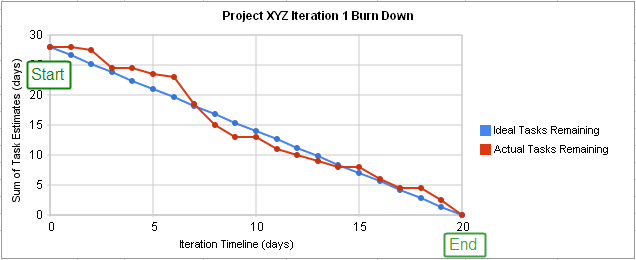The information technology industry has been entirely revolutionized by the use of agile methodologies. But, what exactly is Agile? You may ask.
According to one definition, agile is a project management methodology that consists of small development cycles, aka ‘sprints’, to keep the focus on bringing continuous improvement in a product or service. Sprint is a pre-determined timeframe for the team to complete a particular task. Each sprint usually ends with a review where the team reviews their performance and discusses ways to improve the work.
Agile methodology is being widely adopted by numerous industries where the focus is to build products or services through a continuous cycle of small changes. As opposed to the Waterfall approach that uses a step-by-step technique for product development, Agile best practices focus more on bringing flexibility with constant updates throughout the process.
According to Capterra almost 71% of the organizations nowadays have reported using the agile methodology for their operations, sometimes or always. Another survey showed that agile projects are 28% more successful than the traditional ones. This shows how popular this technique is for the development of products and services.
In other words, ‘Agile Best Practices’ is a parent term for a broad range of frameworks, and practices that guide these frameworks. Some of the famous project management frameworks for agile include Scrum, Kanban, Lean, and XP.
Also Read:
Scrum vs Kanban vs Agile vs Waterfall – A side-by-side comparison
Before moving forward to agile best practices for implementation of each of them, let’s have a look at some of the generic practices to perform effective agile project management:
Agile Best Practices
1. Iterative Development
Through agile iterative development, bigger projects are broken down into smaller chunks and continuous tests are done in repetitive cycles. Through this practice, agile teams get a perspective on new features that need to be added to the final product or service and contribute towards more flexible product development.
2. Daily Meetings
Regular meetings are key to agile implementation. These meetings should be short and concise, with each member of the team explicitly stating the progress of tasks and what needs to be done. This practice is a great way to monitor the performance of the team and check if there are any obstacles in the way of product development.
3. Using Professional Tools
Using project management tools for the implementation of agile methodology helps the team to better structure their workflows and improve team collaboration. For proper documentation and meetings management, professional project management software can greatly reduce the effort it takes to manage your tasks otherwise.
One such tool that you can easily use is nTask. A comprehensive software, with the most intelligent features, provides a smart over-all coverage to all your agile project management needs.
Now, coming towards the practices of popular agile methodologies.
Agile Best Practices: Scrum Project Management
Scrum is considered to be a dominant agile framework, with stats showing that 58% of the organizations implement this for their products’ development and 18% of organizations use it in combination with other frameworks.
Some agile best practices for Scrum implementation are:
1. Creating Product Backlog and Product Vision Together
A product backlog is an ordered list of items that are required to be added to product development. A good practice for scrum implementation is to create the product backlog and product vision together so that both the development team and stakeholders are on the same page. This ensures mutual understanding and helps in aligning the vision in a better way.
2. Use Burndown Charts for Sprints
A daily burndown chart is a great way of monitoring the progress of Sprints. Burndown charts graphically show the work that has been done and the total work remaining against time. It’s a useful tool to inform the team about project scope and make them aware of scope creep that might occur. These charts also help in identifying the risks associated with undelivered work.

3. Setting communication guidelines for teams
Uninterrupted communication is key for the Scrum framework and can become a bottleneck if not tackled efficiently. An effective way to ensure seamless communication is to formulate a communication strategy with all the essential guidelines for teams. This particular practice can really come in handy for remote teams as it will make team goals transparent.
4. Practicing Stand-Ups
Also known as the ‘Daily Scrum’, stand-ups are short meetings held with the team members on a daily basis. These meetings are typically for a maximum of 15 minutes to keep their duration short. Practicing Stand-ups for product or project development are a great way to monitor the progress of work and helps in keeping everyone in the loop with the project updates. These meetings also assist the team in tracking the dos and don’ts of product development.
Agile Best Practices: Kanban Project Management
Kanban method was developed by Japan to control the demand and supply of materials in the production lines using colored cards. Later on, it was adopted for other workflows as well in the form of defined boards for task to-do lists, such as ‘not started’, ‘in-progress’, and ‘done’.
For successful implementation of Kanban, the following agile best practices can be adopted:
1. Visualizing Workflows
Visualizing workflows in the form of boards or cards showing the progress status of each task is an easy way to keep track of tasks and point out hurdles in the product development cycle. These boards generally come with the option of dragging and dropping the tasks from one pane to another to show the progress.
2. Limiting Work in Progress
Fixed constraints for work in process limit the total amount of cards in the active pane, consequently helping the team in understanding the work that needs to be done within a stipulated timeframe. By limiting the unfinished work, a constant need for re-prioritizing tasks is eliminated and bottlenecks are identified more effectively.
3. Continuous Feedback
Continuous feedback from team members is critical in order to understand how the team is going along with the process. The feedbacks also help in identifying any hurdles that might be occurring in the product development cycle and reflecting on what needs improvement.
See Also: How to encourage feedback learning at work?
4. Focusing on Flow
Monitoring the flow of work items assists the team in keeping an eye on overall work progress, giving them an idea of how quickly they need to move along with the process. This flow facilitates the team in understanding the speed and smoothness of delivery.
A ‘Good’ flow reveals a steady and predictable work system, whereas a system where work starts and stops frequently is labeled as ‘Bad’.
Lean Development Model
The essence of lean project management is to implement lean manufacturing principles to project management processes. These principles essentially focus on eliminating waste or anything that is not adding any value to the work.
Some of the practices for the successful implementation of lean project management are as follows:
1. Identifying Value
Carefully break down complex projects into smaller tasks and sub-tasks to identify the value associated with each one of them. This practice will lead to a better understanding of workflows and will help in identifying the unnecessary tasks that need to be eliminated, thus adding more value to the workstream.
2. Reducing Waste
From the project management perspective, reducing waste addresses the elimination of any tasks, meetings, or documentation that are of no value to the overall product development. This elimination gives a clear direction to the team members and contributes towards the actual value addition process.
3. Continuous Improvement
To successfully implement lean project management, there would be a constant need for improvements throughout the project development. One practice to achieve improvements is to clearly communicate the requirements and guidelines to team members for achieving more with minimal waste.
See also: 15 Best Project Management Certifications and Courses of 2024
Extreme Programming (XP)
Extreme programming framework of agile project management is used for developing higher quality software while increasing the productivity of developers and identifying the best way to collaborate on code.
Notable Agile best practices associated with XP are:
1. Planning Game
All team members of a team should meet and participate in the planning process. There should be no ambiguity between the team(s) working on a particular project. This can take the form of meetings that occur after defined intervals to make updates and monitor progress accordingly.
2. Test-driven Development
Before the final code, continuous tests are run to check the functionality of individual pieces of code. This practice helps programmers to go through situations where the code might fail. It also helps in lowering the defects and saves time to develop the software.
3. Small Releases
Working on a similar principle of iterations, this concept focuses on small releases throughout the lifecycle of product development. This particular practice helps the entire team in understanding how the product is coming along, and identifying any glitches that might occur during the product development cycle.
4. Practicing Simple Design Would Help In…
The simple design of software requires less time to write and takes minimum effort to fix problems. This practice also helps in cutting down the overall costs of developing a product and paves way for team members to always find an easier way to get things done.
So, as you can see, these agile best practices are basically a rich array of options to choose from. The secret to adopting a ‘best’ practice lies in understanding your business and team needs better and then addressing those needs accordingly.

